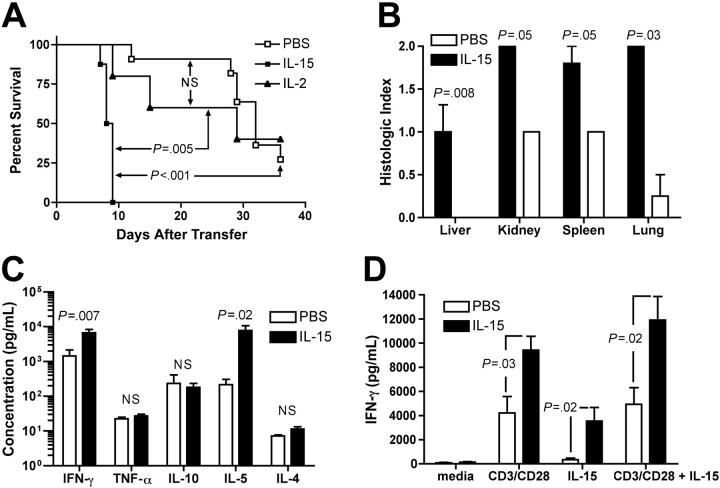Figure 1.
Recombinant human IL-15 increases X-GVHD mortality, morbidity, and serum IFN-γ. (A) Hu-PBL-SCID mice treated with rhIL-15 demonstrated a median survival time of 8.4 days compared with 25 days for mice treated with rhIL-2 (P = .005) and 30.7 days for mice treated with PBS (P < .001). There was no statistically significant difference in survival between IL-2- and PBS-treated mice. N.S. indicates not significant. (B) Blinded analysis of X-GVHD histopathology revealed a significant increase in mononuclear-cell infiltration and tissue damage in the livers (P = .008), kidneys (P = .05), spleens (P = .05), and lungs (P = .03) of IL-15-treated mice compared with PBS-treated mice. (C) Serum was harvested from hu-PBL-SCID mice at day 10 and analyzed for the presence of human cytokines. Mice treated with rhIL-15 demonstrated increased serum human IFN-γ (P = .007) and IL-5 (P = .02) compared with PBS-treated mice. (D) Splenocytes were harvested from hu-PBL-SCID mice treated with either IL-15 or PBS and cultured (2 × 106/mL) in 24-well plates for 48 hours in the presence of anti-CD3/CD28 beads, rhIL-15 (5 ng/mL), both, or media alone. Human IFN-γ was measured in culture supernatants by cytometric bead array. Survival data were compared using the log-rank test, and all other data were compared using Student t test or the exact Wilcoxon rank sum test. Error bars indicate standard error of the mean.

